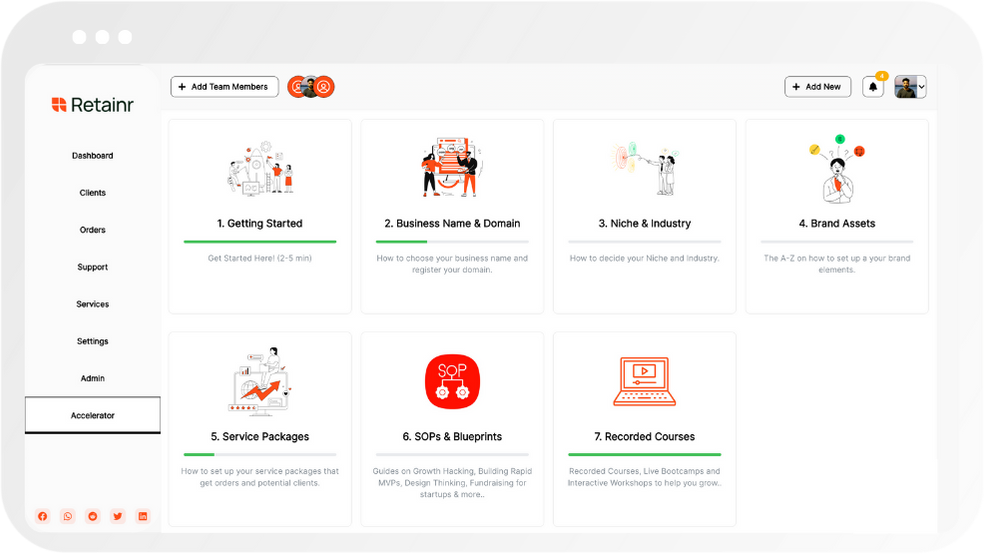
8 Tips and Tricks for Seamless Communication in Remote Teams
Build with Retainr
Sell your products and services, manage clients, orders, payments, automate your client onboarding and management with your own branded web application.
Get Started1. What are the top tips for seamless communication in remote teams?
Effective Tools for Seamless Communication
Having the right communication tools is the first step towards seamless communication in remote teams. Communication tools like Slack, Microsoft Teams, and Zoom enable real-time communication, collaboration, and meetings. Project management tools like Trello and Asana can also help in enhancing team collaboration through easy task assignment and progress tracking. Moreover, tools like Google Docs enable collaborative editing of documents.
| Type | Tools |
|---|---|
| Communication Tools | Slack, Microsoft Teams, Zoom |
| Project Management Tools | Trello, Asana |
| Collaborative Editing Tools | Google Docs |
Promoting Clear and Consistent Communication
Another crucial aspect of seamless communication in remote teams is to promote clear and consistent communication. This could be achieved through establishing clear protocols for team communication like designating specific channels for particular type of communication or having regular team meetings. Also, ensuring all team meetings have an agenda which is adhered to, can help maintain focus during discussions.
Encouraging Openness and Collaboration
Effective communication is not just about the tools and rules, it’s also about the culture. Encouraging openness and ensuring all team members feel comfortable to share their ideas and feedback is crucial for collaborative decision making. Weekly or bi-weekly team meetings where each team member shares their updates, blockers and ideas, can greatly help in fostering a culture of openness and collaboration.
2. How can we improve our communication within our remote team?
Use the Right Tools
Effective communication in remote teams can be greatly improved by utilizing the right tools. Not only do these tools facilitate communication, but they also aid in organization and collaboration. Communication tools such as Slack or Microsoft Teams provide platforms for instant messaging and file sharing. Video conferencing software like Zoom or Google Meet can help recreate face-to-face meetings, while project management apps such as Asana or Trello keep everyone on the same page.
Ensure to select tools that are user-friendly and address the specific needs of your team. Offering training sessions on how to use these tools can also enhance communication.
Set Clear Communication Guidelines
Another way to improve communication within remote teams is to establish clear communication guidelines. These guidelines should include:
- Which channels to use for different types of communication
- Expected response times
- Schedules for regular check-ins and updates
These guidelines will help ensure everyone knows the best ways to communicate, reducing the likelihood of misunderstandings and missed messages.
Encourage Active Listening
Active listening is critical for effective communication, particularly in remote teams, where non-verbal cues can sometimes be overlooked. A few ways to promote active listening include:
| - Using video calls to better understand non-verbal cues. |
| - Encouraging team members to summarize or paraphrase what others have said to ensure understanding. |
| - Creating a culture of respecting and valuing all team members' voices. |
By creating a culture of active listening, teams can improve their communication and encourage more meaningful and effective interactions.
3. Are there any specific tools recommended for effective remote team communication?
Top Tools for Effective Remote Communication
There is an array of communication tools available designed to make remote team communication seamless and efficient. Top of the line options include:
- Slack: This is a chat-based tool specially designed for group discussions, private conversations, or direct messaging. It can also integrate with other tools like Google Drive and Trello.
- Trello: Considered a project management tool, Trello is excellent for tracking tasks and progress. It allows you to create boards and cards that you can move around depending on their status.
- Zoom: Known for its video conferencing capabilities, Zoom makes remote team meetings easy, due to its stability and ease of use. It also allows recording sessions.
Key Features of Effective Communication tools
An effective remote communication tool needs to have specific features. Beyond video conferencing, instant messaging, and project management, you should also look for the following:
| Feature | Description |
|---|---|
| Integration Capability | The tool should seamlessly integrate with other commonly used tools to streamline workflows. |
| Security | Top-notch security measures should be in place, like end-to-end encryption, to ensure that all communications are safe and secure. |
| Customizable | The tool should be customizable to meet the specific needs of your team. |
Adapting To Effective Communication Tools
Once you've selected your preferred communication tools, it's crucial to ensure team member onboarding is smooth and succeeds. Here are some tips:
- Provide thorough training and resources to familiarize team members with the tools.
- Encourage consistent use and lead by example. If team members see leaders utilizing these tools, they are more likely to use them.
- Collect feedback periodically and try to continuously improve the communication process using these tools. Always stay open to new and potentially better tools.
4. How does clear and concise communication benefit remote teams?
Benefits of Clear and Concise Communication
Clear and concise communication is vital for the efficient functioning of remote teams. Let's explore some benefits of maintaining this kind of communication within remote teams as they conduct daily activities and achieve their set objectives.
- Improved Efficiency: Clear communications eliminate misunderstandings, leading to tasks being handled efficiently. Team members understand their roles, what they have to do, and the expected outcomes.
- Better understanding: Clear communication gives team members a good understanding of their tasks. They can ask for clarifications and understand the feedback provided, improving their productivity.
- Enhanced Collaboration: When communication is clear and concise, it fosters better collaboration among team members. They can easily share ideas, solutions and make decisions effectively.
Role of Concise Communication
Concise communication, on the other hand, is efficient in time management, especially in a remote working environment where multiple time zones might be in play. Below are a couple of benefits that concise communication provides.
| Benefits of Concise Communication |
|---|
| Time-Efficient |
| Prevents Information Overload |
| Enhances Message Retention |
Consolidated Benefits
Incorporating clear and concise communication in a remote team environment leads to improved team performance, streamlined workflows, less confusion and misinterpretation, and a more cohesive workforce. In summary, proper communication practices are integral to the functioning of remote teams and their overall success.
5. Can you provide some tricks for enhancing verbal communication in remote teams?
Enhancing Verbal Communication in Remote Teams
Verbal communication plays a crucial role in remote teams. Unlike in traditional office settings, where employees can effortlessly interact face-to-face, remote communication relies heavily on technology and good communication practices. To improve your team's verbal communication, let's focus on some tips.
- Clarity: It's essential to provide clear and concise messages. Misunderstandings can lead to mistakes or redoing tasks, wasting precious time and resources.
- Active Listening: Show the speaker that you are paying attention by giving feedback, summarizing, and asking questions to clarify.
- Consistent Communication: Regular check-ins and updates keep the team on the same page and avoid confusion. Consider creating a communication schedule so all members know when to expect updates.
- Use Visual Aids: Incorporate graphs, slides, or other visual aids to highlight key points. This can make complex topics easier to understand.
- Engagement: Encourage participation and engagement during team calls. This can be done by asking open-ended questions or asking for team members' opinions.
- Choose the Right Medium: Emails, chats, video calls, or phone calls all have their own advantages and disadvantages. Choose the one that best suits the conversation's needs.
- Positive Tone: Maintain a positive and respectful tone. Being aware of your tone of voice can minimize misunderstandings and conflicts.
- Provide and Request Feedback: Regular feedback can improve team performance and communication. It provides a chance to address any issues and clarify any misunderstandings.
Let's view these traits in a table format for more clarity:
| Tips | Description |
|---|---|
| Clarity | Clear and concise messages to avoid misunderstandings |
| Active Listening | Show the speaker that you are paying attention |
| Consistent Communication | Regular updates and check-ins |
| Use Visual Aids | Use graphs or slides to highlight key points |
| Engagement | Encourage participation during team calls |
| Choose the Right Medium | Select the most suitable way of communication |
| Positive Tone | Maintain a positive and respectful tone |
| Provide and Request Feedback | Regular feedback to improve communication |
6. How significant is the role of video conferencing in remote team communication?
The Importance of Video Conferencing in Remote Team Communication
Video conferencing plays a fundamental role in remote team communication. One cannot underestimate the effectiveness of face-to-face communication even if it's via a virtual platform. Given the rise in the remote work model, video conferencing solutions have become the go-to platform for facilitating effective and efficient team communication.
- Builds Trust: Facial expressions, body language, and tone of voice, communicate more meaning compared to text-based communication. This aids in building trust and understanding in a remote team setting.
- Real-time Communication: Real-time discussions during video conferencing help fast-track decision-making processes, encourage brainstorming, and boost creativity within the team.
- Boosts Engagement: Compared to audio-based and text-based communication, video conferencing is far more engaging. It ensures everyone's presence and active participation in discussions.
The Critical Role of Video Conferencing Tools
Choosing the right video conferencing tool is a crucial decision that remote teams have to make. The solutions you pick will guide your team interactions, influence collaboration, and impact team productivity. Most importantly, it will directly affect the quality of your virtual meetings.
| Video Conferencing Tool | Key Features |
|---|---|
| Zoom | HD Video and Audio, Screen-sharing, Virtual Backgrounds, Calendar Integration, Record Meetings |
| Microsoft Teams | File Sharing, Team collaboration, Meeting recording, Integration with other Microsoft Products. |
| Google Meet | G Suite Integration, Screen-sharing, Live Captions, Low-light mode, Noise cancellation. |
Best Practices While Using Video Conferencing
Having the right tool is just one part of the equation. It's also essential to know how to use these tools effectively for remote communication.
- Maintain Video Etiquette: Make sure that your surroundings are distraction-free, the background is professional, and you're dressed appropriately for the call.
- Make Use of Features: Utilize the various features offered by these tools like the 'Raise Hand' feature or polls to maintain an order in the meeting.
- Ensure Security: Be aware of the privacy settings of your video conferencing tool. Only invite trusted participants, make use of password protection and waiting rooms.
7. What are some effective ways to ensure everyone in a remote team feels heard?
Ensure Everyone's Voice is Heard
Ensuring that everyone feels heard in a remote team where face-to-face communication is non-existent can be somewhat challenging. However, there are effective ways to overcome this. One strategy could be to establish a structured system for meetings where every team member has a specified time to voice their thoughts. The agenda can be circulated in advance so the team members can prepare and contribute effectively.
- Regular feedback session: Regular feedback sessions or one-on-one meetings can help the team members feel heard.
- Anonymous surveys: Anonymous surveys can be an excellent way to capture the thoughts and ideas of people who might be hesitant to speak up.
- Team chats: Designated "open floor" times on team chats can offer individuals another platform to share ideas, questions, or concerns.
Importance of Active Listening
The term 'listening' goes beyond just hearing the words; it's about understanding, acknowledging, and acting upon them if necessary. Active listening can be promoted and adopted by doing the following:
| Action | What it means |
|---|---|
| Paraphrasing | Articulating what the other person has said in your own words. |
| Showing empathy | Showing genuine concern or understanding about the issues and challenges brought up by team members. |
| Asking questions | Deepens understanding and shows interest in what the speaker is saying. |
Ensuring everyone in a remote team feels heard can indeed be challenging but not impossible. It requires a conscious effort on the part of the leaders and team members. Facilitating open conversations, encouraging silent contributors, and practicing active listening can all contribute to creating an environment where everyone's voice is valued.
8. How can we manage time differences to ensure seamless communication in remote teams?
Managing Time Differences in Remote Teams
To effectively manage time differences in remote teams, leaders should implement strategies that accommodate everyone's schedule. These strategies can include:
- Flexible work hours: Instead of expecting everyone to work on a traditional 9-to-5 schedule, consider allowing team members to work when they're most productive within reason. This can help ensure that there's always someone available, no matter the hour.
- Overlap meeting hours: Find a time slot where everyone's work hours overlap and set that as the designated meeting time. This ensures everyone can attend important discussions regardless of where they're located geographically.
- Roster system: Develop a roster system to take turns in adjusting schedules for meetings. This prevents the burden of time differences from always falling on the same individuals.
Use of Digital Tools for Time Management
Today's digital tools can easily help manage time differences in remote teams. Here are a few to consider:
| Tool | Features |
|---|---|
| World Time Buddy | This tool allows you to compare time zones and easily find overlapping working hours. |
| Google Calendar | Google Calendar can automatically adjust meeting times based on participants' time zones. |
| Every Time Zone | This tool features a visual slider that shows the current time in various global locations, making it simple to find common times to communicate. |
Maintaining Communication Quality
While managing time differences, it's essential to maintain the quality of communications. Here are some tips:
- Frequent updates: Keep team members updated with the latest information. This ensures that nobody misses out on important updates due to time zone differences.
- Record meetings: Record meetings and share the recordings and minutes with those who couldn't attend due to time zone differences. This allows them to catch up and contribute their input later.
- Maintain open communication: Leverage a mix of synchronous and asynchronous communication methods to foster open communication and inclusivity within the team.
9. Are there any tips for reducing misunderstandings or miscommunication in remote teams?
Understand the Content before Sharing
The first step to reducing misunderstandings and miscommunications is to thoroughly understand the content before sharing it with your team. If you're not sure about something, don't hesitate to ask. It's always better to clarify everything prior to sharing it with others. Write down your doubts, clarifying items, or anything that seems unclear to your understanding.
- Do your own research if necessary
- If you have doubts or if anything seems unclear, ask the concerned person
- Never share incomplete or misunderstood information
Precise and Organized Communication
Try to keep your communication as precise and organized as possible. This includes not just what you say but also how you say it. Use simple formats and organized tables to share your data or important projects related details. It would make it easier for people to comprehend, thereby reducing the chances of miscommunication.
| Guidelines for Communication |
|---|
| Be clear and concise |
| Use simple and understandable language |
| Organize your data in tables, charts or lists |
Utilize Visuals to Enhance Understanding
Visuals such as images, charts, and videos can significantly reduce misunderstandings in communication. They not only make the information more engaging but also easier to understand. Incorporating visuals in your communication can significantly enhance the understanding of the team members, thereby reducing miscommunication.
- Use suitable images to illustrate your point
- Charts and infographics can explain data more effectively
- Videos can demonstrate processes clearly and in detail
10. How can we foster open and transparent communication within remote teams?
Fostering Open and Transparent Communication
Open and transparent communication is key for the success of any remote team. It helps in building trust, fostering a positive work environment, enhancing productivity and facilitating swift resolution of work issues. This begins with setting the right communication channels and norms for your team.
- Establish Clear Communication Guidelines: Define what needs to be communicated, when and how. This involves setting guidelines about the timeframe within which emails should be responded to, how urgent matters should be communicated, the suitable hours to contact team members etc.
- Utilize Suitable Communication Tools: Use project management tools that allow for easy and real-time communication, collaborative work, task delegation and tracking etc. Examples include Slack, Zoom, Microsoft Teams, etc.
- Regular Check-Ins: Regular one-on-one check-ins between team leaders and members can help in identifying and addressing work issues swiftly. It also aids in understanding individual work styles and promoting a positive team environment.
| Tip | Description |
|---|---|
| Create a virtual 'Open Door' Policy | Encourage team members to speak up about their ideas, work challenges etc. Assure them of your availability and willingness to listen and help. |
| Maintain transparency | Ensure all members are up to date with project progress, developments, changes in roles or policies etc. to avoid any surprises or confusion. |
| Promote Informal Communication | Create opportunities for team members to connect on non-work related matters. This promotes bonding and a sense of team camaraderie. |
Effective communication in remote teams is not just about frequent interaction, but also about the quality of interaction. Encourage open, two-way communication and be proactive in understanding and addressing your team's communication needs.
Conclusion
Effective Communication in Remote Teams
Mastering seamless communication within a remote team can be quite demanding but it is crucial for the efficiency and productivity of your team. Here, let's share 8 essential tips that can help you achieve this.
1. Clear and Concise Communication
Ensure your messages are brief, clear, and straight to the point. This saves time and eliminates misunderstandings or translations.
2. Regular Update Meetings
Regular meetings are vital in a remote working scenario. They can keep everyone in loop about the ongoing projects or tasks.
3. Utilize the Right Tools
Choose suitable remote working tools that can facilitate communication and collaboration among team members. Retainr.io is an exemplary software that can help manage clients, orders, payments, and your own branded app.
4. Foster Team Spirit
Positive team spirit can optimize remote teams communication. Encourage your team to interact freely and openly.
5. Respect for Different Time Zones
Considering and respecting everyone's time zone can ensure smooth communication.
6. Regular Feedback
Regular feedback helps team members to know where they stand and how they're performing. This drives improvement and growth.
7. Effective Email Communication
Make sure to provide clear instructions and sufficient information in emails to prevent back and forth exchanges.
8. Patient Listening
Listening patiently to others can give clarity and help in better understanding of what is being communicated.
To summarise, establishing flawless communication in a remote team can significantly increase productivity and work satisfaction. To facilitate this process, consider using software like Retainr.io that offers solutions for selling, managing clients, orders, payments, and your own branded app. Go ahead and take your remote team communication to a whole new level.
Boost Your Agency Growth
with Retainr Accelerator
Uncover secrets, strategies, and exclusive blueprints to take your agency's growth to the next level — from marketing insights to effective presentations and leveraging technology.

SOPs, Cheatsheets & Blueprints
Leverage 50+ SOPs (valued over $10K) offering practical guides, scripts, tools, hacks, templates, and cheat sheets to fast-track your startup's growth.
Connect with fellow entrepreneurs, share experiences, and get expert insights within our exclusive Facebook community.
.jpg)

Join a thriving community of growth hackers. Network, collaborate, and learn from like-minded entrepreneurs on a lifelong journey to success.

Gain expertise with recorded Courses, Live Bootcamps and interactive Workshops on topics like growth hacking, copywriting, no-code funnel building, performance marketing and more, taught by seasoned coaches & industry experts.

.jpg)

.jpeg)


